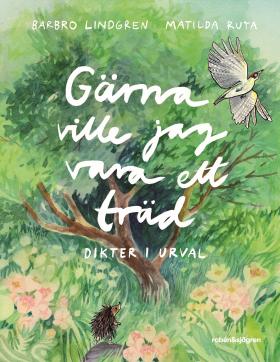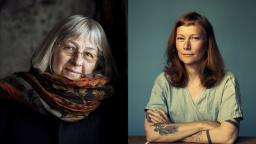
Gärna ville jag vara ett träd: dikter i urval
(I’d Like to Be a Tree: Selected Poems)
by Barbro Lindgren and Matilda Ruta
reviewed by Elizabeth Lutz
Life’s ordinary mysteries are celebrated in this collection of twelve poems by renowned author Barbro Lindgren and illustrated by Matilda Ruta. The poems use simple language and appear to take up little space on the page, yet Lindgren is able to delve straight into existential subjects within very few words. She uses nature as a metaphor for emotions and connects humans to nature in a way that leaves readers feeling fascinated by the mysteries of life on earth.
These poems have been selected from Lindgren’s previously published work, including Gröngölingen är på väg: dikter för barn och andra (The Green Woodpecker is on His Way: Poems for Children and Others) originally published in 1974, Vi leker att du är en humla (Let’s Pretend You’re a Bumblebee), a poetry anthology Lindgren contributed to in 2000, and Rosas Sånger (Rosa’s Songs) from 2004, poems that feature Lindgren’s beloved bull terrier.
Two of the poems examine birth and death, ‘Nu föds ett barn’ (Now A Child Is Born) and ‘Någon gång ska vi dö’ (Someday We Will Die). In both poems, Lindgren creates an immediate connection between listener and speaker, as with a child listening to an adult. In ‘Nu föds ett barn’ this is through the lines ‘En stund på jorden/föddes du’ (One moment on earth/you were born). In ‘Någon gång ska vi dö’ this is the line ‘du och jag’ (you and I). She then distances again, describing a more general someone breathing for the last time and someone seeing for the last time, in the case of ‘Nu föds ett barn’, and all people, all animals, all trees, all flowers in ‘Någon gång ska vi dö’. Lindgren makes no mention of an afterlife in her presentation of death in these poems. She concludes each poem with an observation. In ‘Nu föds ett barn’: ‘Varenda dag/är alltid första dagen/och den sista’ (Each day/is always the first day/and the last). The emphasis falls on the now, the living out of these moments in time on earth. The concluding lines of ‘Någon gång ska vi dö’ state that since not everything dies all at the same time, death is hardly noticed. Death is one of the ordinary mysteries of living on the earth. The two poems, like the majority of the other poems in the collection, use sparse punctuation and include no full stops at the end, indicating the openness of their conclusions.
In other poems, Lindgren uses nature as a metaphor for emotions. One example is from ‘Jag ligger på en äng’ (I Lie in a Meadow), which indirectly expresses yearning by referencing the distant destinations of rivers and the day’s continual disappearance into night. Similarly, in ‘I natt drömde jag’ (Last Night I Dreamed), Lindgren uses characteristics of the ocean, grass, earth, sun, stars, and moon to express an emotional turmoil not directly named in the poem. In a dream, the ocean roared, the earth was black, the moon was ‘het som en ugn’ (hot as an oven). Matilda Ruta’s illustrations complement the subjects of these poems nicely. In the illustration paired with ‘Jag ligger på en äng’ the viewer looks upward from a position on the ground, gazing at the underside of bright red poppies, glowingly white daisies, and trees so tall that their thick, distant branches appear to be about the size of twigs. The effect created is of something far beyond reach. Ruta evokes an emotional response in viewers with her depiction of the ocean for ‘I natt drömde jag’. She captures the rough motion of the waves and an overcast sky dripping jagged streaks of deep blue-grey.
The poems often connect humans to nature. In the title poem of the collection, the speaker feels an intense affinity with a tree, a stone, and an ocean. Lindgren’s use of parallel structure in each verse and repetition of the phrases ‘Gärna ville jag vara’ and ‘ja, gärna ville jag vara’ (I’d like to be; yes, I’d like to be) in this poem is suggestive of the patterns and repeated cycles of nature. ‘Lägg en sten i din hand’ (Hold A Stone in Your Hand) invites a comparison between short human lifespans and the ancient endurance of stone. Its second verse makes readers feel both small and also important at the same time—small, because no one is as old as a stone, and important, because you are alive and the stone is not! Matilda Ruta’s background in ecology and her recent work on the Jordbok (Earth Book) series makes her an excellent choice for illustrating this collection that encourages readers to connect with nature.

Gärna ville jag vara ett träd: Dikter i urval
Rabén & Sjögren, 2024, 32 pages
Rights: Rabén & Sjögren Agency
Barbro Lindgren is the author of over 100 books for children and adults. She has been awarded The Astrid Lindgren Prize, The Nils Holgersson Plaque, and the Astrid Lindgren Memorial Award. In 2023, she was awarded De Nios Grand Prize for ‘her untamed and breathtaking literary work for all ages.’ Barbro Lindgren lives on Öland, Sweden. Matilda Ruta is the author and illustrator of the picture book series Strandskogen (Beach Forest) and the Jordbok (Earth Book) series for older readers. She also illustrated Åka buss (The Bus Ride) by Henrik Wallnäs (reviewed in SBR 2016:1). She received the Lennart Hellsing Grant from Rabén & Sjögren in 2023. Matilda Ruta is a member of the Swedish Academy for Children’s Books and lives in Stockholm.
